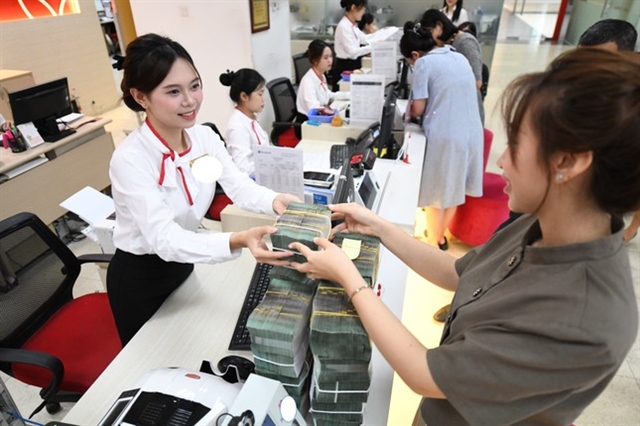Less attractive rates cause savings withdrawals in favour of other investment channels
Savings seem to no longer be a top priority for many people, making it difficult for banks to raise medium- and long-term capital.

HÀ NỘI — The decrease in bank deposit interest rates has made savings less attractive, as customers have been gradually withdrawing money from banks to find other investment channels.
According to statistics released by the State Bank of Vietnam (SBV) last week, deposits from economic organisations have decreased after five consecutive months of increases, causing bank capital mobilisation to decline. Specifically, deposits from economic organisations have decreased by 3.04 per cent compared to the end of last year.
The decrease in deposits comes as savings interest rates have been declining continuously since after the Tết (Lunar New Year) Holiday.
On February 25, the SBV held an urgent meeting with commercial banks and instructed them to cut deposit interest rates. The meeting came after Prime Minister Phạm Minh Chính issued a directive for the SBV to inspect commercial banks that increased their deposit interest rates and strictly handle violations.
Immediately after this meeting, the banks lowered their deposit interest rates. From February 25 to April 14, 27 banks adjusted their deposit interest rates down, with a reduction of 0.1-1.05 percentage points per year, depending on the term.
Currently, only a few banks, including GPBank, Vikki Bank and HDBank, maintain deposit interest rates above 6 per cent per year.
An investor who declined to be named said that the current savings interest rate was around 6 per cent per year, while the price of SJC gold bars and gold rings was anchored at historical peaks. Since the beginning of this year, the price of SJC gold bars had increased by more than VNĐ22 million per tael, equivalent to a net increase of more than 26 per cent. Many people had therefore withdrawn their savings to buy gold.
Experts also admit that savings seem to no longer be a top priority for many people, making it difficult for banks to raise medium- and long-term capital. This will likely cause a tightening of bank liquidity, affecting the amount of capital available to support economic growth.
CEO of the FIDT Investment and Asset Management Consulting Company Ngô Thành Huấn said the current low interest rate cycle would likely end this year, officially marking the end of the initial economic recovery phase and entering a pre-growth phase.
As low interest rates caused many depositors to switch to other investment channels such as stocks, real estate and gold, Huấn said that this was a normal development of the economic cycle and that the flow of money to other channels would help stimulate growth again.
To ensure enough capital is available to serve the economy, banks have been seeking ways to attract funding through policies like issuing bonds and borrowing from international organisations.
According to a recent corporate bond market report from financial data provider FiinGroup, in terms of the outstanding value structure of corporate bonds, the banking industry continues to lead, accounting for 44 per cent of the outstanding value of corporate bonds in the entire market.
SBV’s Deputy Governor Đào Minh has said that as the growth of capital has been slower than credit growth, the SBV will use tools to support liquidity for banks, creating conditions for credit to support the Government’s economic growth target of 8 per cent. — BIZHUB/VNS
- Tags
- banking





